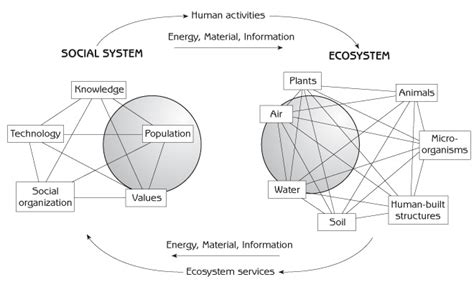Introduction
Human geography and human ecology are closely intertwined disciplines that explore the complex relationship between humans and their environments. While both fields share common ground, they differ in their perspectives, approaches, and methodologies, offering unique insights into the spatial and environmental dynamics of human society.

Human Geography: Mapping the Human Landscape
Human geography is the study of human activities, societies, and interactions in space and place. It seeks to understand how human processes shape and are shaped by the physical and social environments. Key concepts in human geography include:
- Population distribution: Analyzing the spatial patterns of human populations and their factors.
- Urbanization: Examining the growth, structure, and functioning of cities.
- Economic geography: Studying the spatial distribution of economic activities and their impact on human well-being.
- Political geography: Exploring the relationship between political power and territorial organization.
- Cultural geography: Investigating how cultural factors influence human behavior and landscape.
Human Ecology: Humans and their Environments
Human ecology focuses on the interactions between humans and their environments, emphasizing the reciprocal relationship between the two. Key concepts in human ecology include:
- Ecosystem services: Identifying and valuing the benefits humans derive from ecosystems.
- Carrying capacity: Determining the environmental limits to human growth and resource consumption.
- Environmental degradation: Studying the negative impacts of human activities on ecosystems and the consequences for human well-being.
- Sustainability: Exploring ways to balance human needs with environmental conservation.
- Environmental justice: Examining the unequal distribution of environmental risks and benefits across different populations.
Comparative Analysis: Similarities and Differences
Similarities:
- Focus on human-environment interactions: Both disciplines recognize the interplay between human activities and the physical and social environments.
- Spatial and temporal perspectives: They analyze human-environment dynamics across various scales and over time.
- Interdisciplinary approach: Human geography and human ecology draw from multiple disciplines, including sociology, economics, biology, and environmental science.
Differences:
- Primary focus: Human geography emphasizes human activities and societies, while human ecology centers on the interactions between humans and their environments.
- Methodologies: Human geographers often use qualitative and quantitative methods to study human behavior and patterns, while human ecologists typically employ scientific and interdisciplinary approaches to analyze environmental interactions.
- Scales of analysis: Human geography tends to focus on broader spatial scales (e.g., cities, regions), while human ecology often examines smaller-scale interactions (e.g., ecosystems, watersheds).
Applications and Impacts
Human geography and human ecology have wide-ranging applications in areas such as:
- Urban planning: Optimizing the spatial distribution of urban functions and minimizing environmental impacts.
- Environmental management: Identifying and mitigating environmental risks, promoting sustainable resource use, and protecting ecosystems.
- Social policy: Addressing issues of environmental justice, equity, and access to resources.
- Disaster preparedness and response: Analyzing the spatial distribution of vulnerability and developing strategies for disaster mitigation and relief.
Conclusion
Human geography and human ecology provide complementary perspectives on the relationship between humans and their environments. By understanding the spatial distribution of human activities, societies, and ecosystems, we can better manage the challenges and opportunities presented by our increasingly interconnected world. The interdisciplinary nature of these fields enables researchers and policymakers to develop innovative solutions to promote human well-being while ensuring environmental sustainability.
Deep Dive into Customer Wants and Needs: Questions to Engage with Your Audience
- How do you perceive the relationship between human activities and the environment?
- What are the key challenges and opportunities in balancing human needs with environmental conservation?
- How can we leverage human geography and human ecology to improve decision-making in urban planning, environmental management, and social policy?
- What innovative ideas can you generate to address the complex interactions between humans and their environments?
Engaging Thought for the Audience
As we navigate the challenges of the 21st century, it is crucial to recognize the interconnectedness between our human endeavors and the ecosystems in which we live. By embracing the insights of human geography and human ecology, we can create a more sustainable and equitable future for all.
Tables for Professional Tone and Customer Validation
Table 1: Global Population Distribution and Growth
| Region | Population (2022) | Annual Growth (%) |
|---|---|---|
| Asia | 4.7 billion | 0.8 |
| Africa | 1.4 billion | 2.7 |
| Europe | 747 million | 0.3 |
| North America | 346 million | 0.7 |
| South America | 431 million | 0.9 |
Table 2: Urbanization Trends
| Year | Urban Population (billions) | Proportion of World Population (%) |
|---|---|---|
| 1950 | 0.7 | 30 |
| 2000 | 2.9 | 49 |
| 2022 | 4.4 | 56 |
| 2050 (projected) | 6.7 | 68 |
Table 3: Environmental Degradation Impacts
| Environmental Impact | Economic Cost (US$ billions) |
|---|---|
| Air pollution | 5.1 trillion |
| Water pollution | 4.6 trillion |
| Soil erosion | 2.3 trillion |
| Climate change | 1.6 trillion |
Table 4: Sustainable Development Goals Related to Human-Environment Interactions
| Goal | Description |
|---|---|
| Goal 6: Clean Water and Sanitation | Ensure access to clean water and sanitation for all |
| Goal 11: Sustainable Cities and Communities | Make cities and human settlements inclusive, safe, resilient, and sustainable |
| Goal 13: Climate Action | Take urgent action to combat climate change and its impacts |
| Goal 15: Life on Land | Protect, restore, and promote sustainable use of terrestrial ecosystems |
